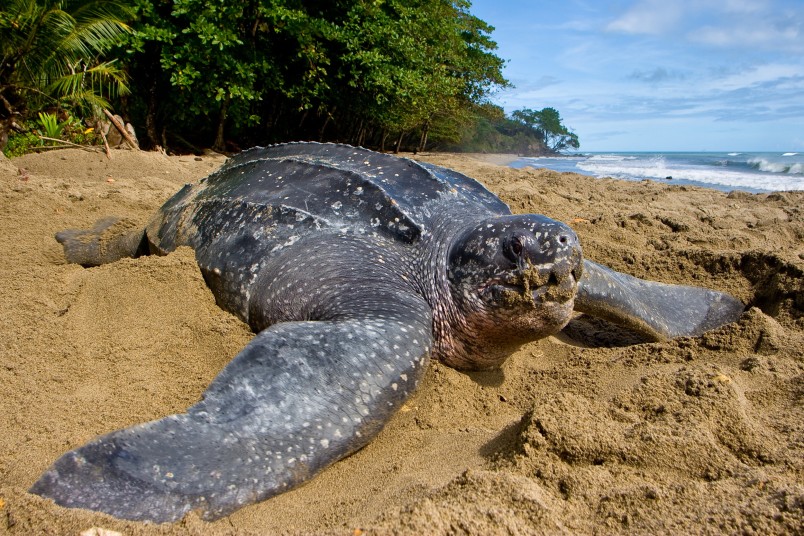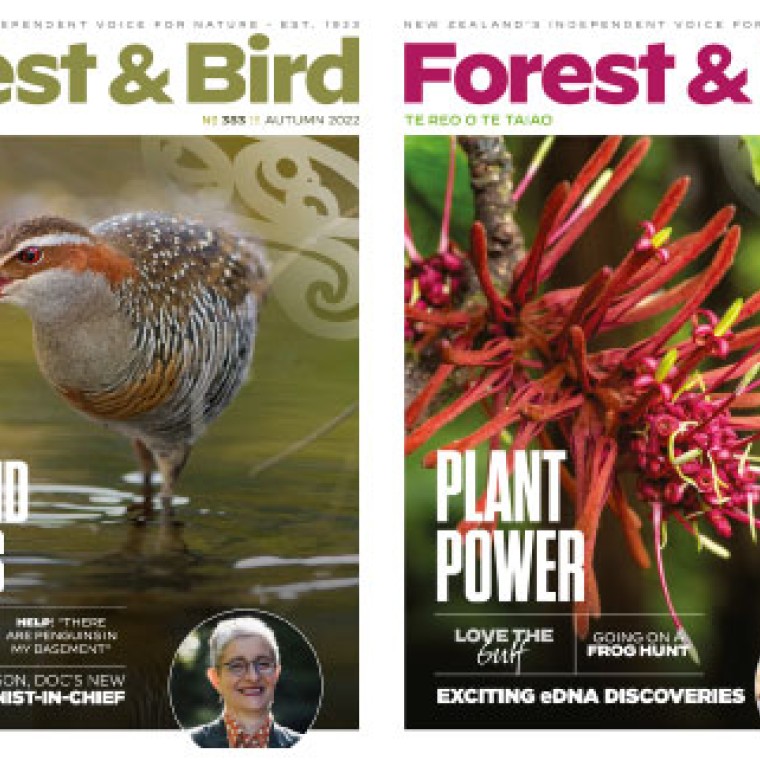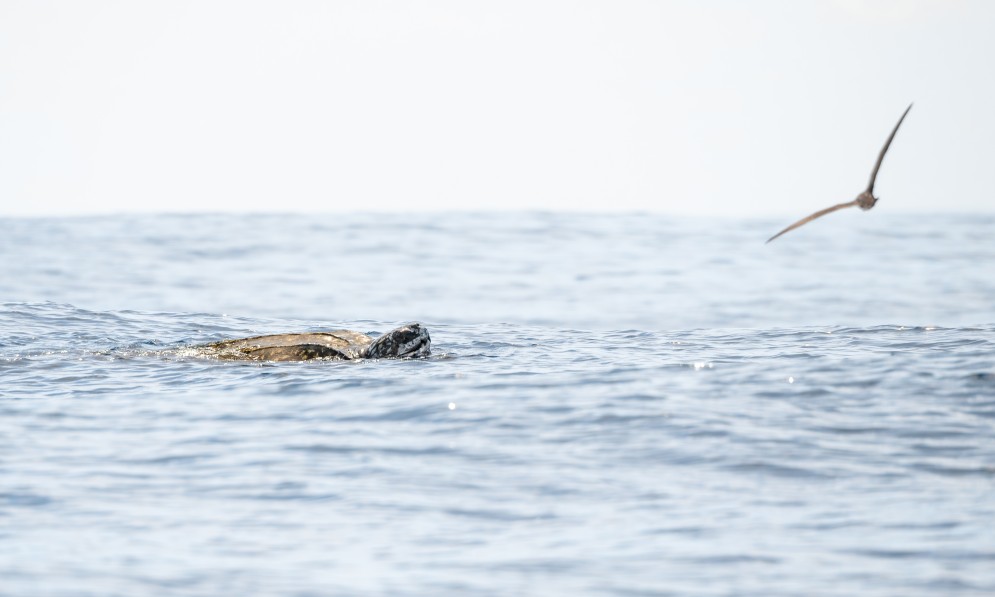Western Pacific leatherback turtles are in big trouble. Peter Langlands looks at how we can better protect these giants of the ocean when they visit our waters.
Forest & Bird magazine
A version of this story was first published in the Summer 2024 issue of Forest & Bird magazine.
Many of us do not associate New Zealand waters with honu marine turtles, thinking of them being more at home in tropical waters. Yet five species of honu have been sighted in our seas (see poster below), with one species in particular – leatherback – being recorded more frequently over the past decade.
Leatherbacks (Ermochelys coriacea) are massive, by far and away the largest of all the marine turtles, and one of the largest reptiles on earth.
New Zealand’s northern waters are considered a seasonal home for a significant number of leatherback turtles. They are very distinctive when sighted at sea, having an elongated shell with longitudinal ridges running down it and a head that projects out at a slightly upward angle.
There have also been sightings in our coastal waters, especially in the Hauraki Gulf and outer Bay of Plenty, where they are encountered by New Zealanders out boating or kayaking during summer.
Warming ocean temperatures are considered to be one reason there may have been an increase in local encounters with leatherback turtles, especially in the last five years.
The leatherback turtle spends most of its life in the open ocean. Its activity is influenced by the occurrence of its prey (primarily jellyfish) in the water column, feeding at depth during the day and near the surface at night.
The main risk leatherbacks face in New Zealand waters is being killed or injured after becoming entangled or hooked on surface longlines used by some commercial fishers. In New Zealand, all sea turtles are protected, but there are currently no fisheries bycatch mitigation measures in place.
More than 225 leatherback turtles have been reported as bycatch in New Zealand waters over the past 15 years. The risk is exacerbated by their sheer heft.
They weigh 225–900kg and range in size from 1.2m to 2.4m. It’s hard to bring these large turtles on board a fishing boat when caught up in a longline, and many are cut off the line, sometimes with a hook left in them.
They are also sometimes “foul-hooked”, with a hook in their flippers rather than their mouth. Thankfully in these cases, they can often be rehabilitated without any significant injury.

Leatherback entangled in fishing line, Grenada. Image Kate Charles/SWOT
However, it is still estimated that about 50 leatherback turtles were likely killed from reported bycatch in our waters over the last 15 years, based on recent research by MPI on the survival of leatherback turtles caught in surface longline fisheries.
Leatherbacks are the largest and globally most widespread of all the marine turtles found in the Pacific, Indian, and Atlantic Oceans. They can even venture into sub-Antarctic and sub-Arctic waters.
No doubt their size allows them greater temperature tolerance than other turtles. They can maintain their body temperature well above ambient water temperatures, which allows them to dive deeper (up to 1280m) and occur in cooler water than any other marine reptile.
While globally distributed, there is concern about their future. The western Pacific population is seen as especially vulnerable. It is estimated to have declined by 90% in recent decades as the result of longline and pelagic driftnet fishing.
The western Pacific subpopulation is assessed as “Critically Endangered” by the IUCN Red List of Threatened Species.
The leatherback turtles encountered around New Zealand are most likely to be from the western Pacific subpopulation, originating from nesting beaches at the Solomon Islands, Indonesia, and Papua New Guinea.
With the breeding population of western Pacific leatherback turtles numbering only a few thousand individuals in any one year, it’s clear this honu sea turtle needs human help to survive.
New Zealand can play its part in the global conservation effort by mitigating the bycatch risk to leatherbacks from surface longline fishing in our waters.
The issue has been studied by NIWA and the Department of Conservation.
NIWA scientist Mike Dunn is the main author of an insightful 2023 scientific paper “Increased captures of the critically endangered leatherback turtle (Dermochelys coriacea) around New Zealand: the contribution of warming seas and fisher behaviour” (https://bit.ly/3CvG308).
The positive side of the story is that many captures have been self-reported by commercial fishers and many turtles are released alive with minor injuries following a bycatch encounter.
This shows that New Zealand fishers are concerned and may wish to be part of the solution.
Of course, we don’t know how many were hooked and not reported. Having increased observer coverage on longline vessels would help us get a clear picture of the extent of the leatherback turtle bycatch problem.
Honu face many problems on the high seas, but fisheries bycatch is a focused and solvable problem within New Zealand’s waters.
However, sea turtles have been overlooked in fisheries bycatch profiles, with seabirds and marine mammals receiving more attention to date. Aotearoa currently has no clear mitigation methods in place to minimise leatherback turtle bycatch in our waters.
A focus group set up under the Conservation Services Programme, which helps fund the investigation and mitigation of fishing impacts on protected species through a commercial fishers’ levy, aims to change the story and address some of the risks to these globally endangered turtles.

Nesting leatherback, Trinidad. Image J Hutchison
Leatherbacks are mainly taken as bycatch in the broad-bill swordfish and big-eye tuna fisheries, both of which are also in rapid decline.
The bycatch issue could be helped by working with a small number of fishers responsible for a significant number of leatherback turtle catches in known hotspots within the Bay of Plenty and East Cape regions. Changes in longline techniques may be required, just as fishers have done for albatross.
Introducing a seasonal ban on longline fishing in known leatherback turtles' areas may be required in some areas.
Having DOC, the Ministry for Primary Industries, and commercial fishers working together is essential if we are to solve the local leatherback turtle bycatch issue, especially in the Bay of Plenty.
The turtle’s plight also challenges New Zealand to be part of the global solution, just as we are for migratory seabirds.
Working with other conservation groups to secure leatherback breeding grounds on the Soloman Islands (and other international sites) is important. Scientists could also record incidence of hook bycatch on turtles arriving at breeding beaches.
Reducing marine plastic is also crucial as leatherbacks feed on jellyfish and are vulnerable to ingestion of floating plastic objects, especially plastic bags.
While logistically challenging, it would be helpful to get more satellite transmitters on leatherback turtles. This would give some insight in the species ecology as they transit from our waters to their breeding grounds several thousand miles away.
Researchers recently tracked an adult female more than 19,000km using satellite telemetry, from Indonesia to Oregon, one of the longest recorded migrations of any animal.

Leatherback hatchling, Panama. Image Morrison Mast
It would be tragic to lose leatherbacks, part of the marine megafauna that has survived on our planet for approximately 150 million years. Local and international co-operation is urgently needed to conserve this magnificent marine species.
I have set up a Facebook group to discuss leatherback turtle conservation in New Zealand further. Please join if you are interested – search for “Leatherback turtle sightings and conservation awareness NZ.”
Peter Langlands is a researcher, writer, and photographer specialising in marine and freshwater issues.

Turtles of Aotearoa illustration. By kind permission Shaun Lee
Spot a turtle?
Five of the world’s seven species of sea turtles are known to occur in New Zealand waters. The leatherback turtle is most frequently reported, followed by green turtle, hawksbill turtle, loggerhead turtle, and olive ridley turtle.
If you see a turtle this summer, please photograph it and report to the Department of Conservation by emailing turtles@doc.govt.nz. If it is injured or stranded call the DOC emergency hotline 0800 DOC HOT (0800 362468).
The main period to watch for turtles is from January to April.

